Feature Engineering 7 - Outliers and Its impact on ML usecases
Outliers and Its impact on Machine Learning!!
What is an outlier?
An outlier is a data point in dataset that is distant from all other observations. A data point that lies outside the overall distribution of the dataset.
What are the reasons for an outlier to exist in a dataset?
- Variability in data
- ans experimental error
What are the impacts of having outliers in dataset?
- It causes various problems during our dtatistical analysis.
- It may cause a significant impact on the mean and the standard deviation.
What are the criteria to identify an outlier?
- Data points that falls outside of 1.5 times of IQR above the 3rd quartile or below the 1st quartile. (in case of skewed feature)
- Data points that falls outside of 3 standard deviations. we can use a z score and if the z score falls outside of 2 standard deviation. (in case of normally distribured feature)
Various ways of finding the outliers.
- using scatter plots.
- Using Box plot
- Using z-score
- Using the IQR (InterQuantile Range)
Which machine learning models are sensitive to outliers?
- Naive Bayes Classifier -> No
- SVM -> No
- Linear Regression -> Yes
- Logistic Regression -> Yes
- Decision Tree regressor or Classifier -> No
- Ensemble(RF,GBM,XGBoost) -> N0
- KNN -> No
- KMeans -> Yes
- Hierarchical Clustering -> Yes
- PCA -> Yes
- LDA -> Yes
- Neural Network -> Yes
How to treat outliers?
- If outliers are important in our domain, then we should keep it (e.g. Fraud detection) * we should apply those ML algorithm which are not sensitive to outliers in this case
- Else we can remove the same or impute with some other values.
import pandas as pd
import numpy as np
import matplotlib.pyplot as plt
import seaborn as sns
%matplotlib inline
df=pd.read_csv('Datasets/Titanic/train.csv')
df.head()
| PassengerId | Survived | Pclass | Name | Sex | Age | SibSp | Parch | Ticket | Fare | Cabin | Embarked | |
|---|---|---|---|---|---|---|---|---|---|---|---|---|
| 0 | 1 | 0 | 3 | Braund, Mr. Owen Harris | male | 22.0 | 1 | 0 | A/5 21171 | 7.2500 | NaN | S |
| 1 | 2 | 1 | 1 | Cumings, Mrs. John Bradley (Florence Briggs Th... | female | 38.0 | 1 | 0 | PC 17599 | 71.2833 | C85 | C |
| 2 | 3 | 1 | 3 | Heikkinen, Miss. Laina | female | 26.0 | 0 | 0 | STON/O2. 3101282 | 7.9250 | NaN | S |
| 3 | 4 | 1 | 1 | Futrelle, Mrs. Jacques Heath (Lily May Peel) | female | 35.0 | 1 | 0 | 113803 | 53.1000 | C123 | S |
| 4 | 5 | 0 | 3 | Allen, Mr. William Henry | male | 35.0 | 0 | 0 | 373450 | 8.0500 | NaN | S |
df.isna().sum()
PassengerId 0
Survived 0
Pclass 0
Name 0
Sex 0
Age 177
SibSp 0
Parch 0
Ticket 0
Fare 0
Cabin 687
Embarked 2
dtype: int64
sns.distplot(df.Age.dropna())
<matplotlib.axes._subplots.AxesSubplot at 0x7fd2c6773510>
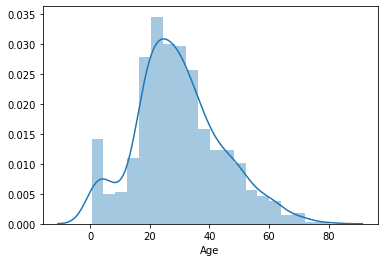
#Just trying to visualise by adding outlier (after replacing NAN values by 110)
sns.distplot(df.Age.fillna(110))
<matplotlib.axes._subplots.AxesSubplot at 0x7fd2c6a3ead0>
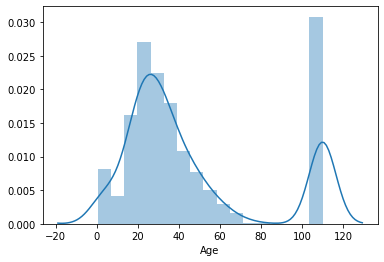
-
whenever my data follows normal distribution curve, at that time we use technique -> Estimate outliers (or ExtremevalueAnalysis) and we try to find IQR
-
when my data is skewed we use different techniques
Case 1 :- If features follow Gaussian or normal Distribution
plt.figure(figsize=(12,8))
figure=df.Age.hist(bins=50)
figure.set_title('Age')
figure.set_xlabel('Age')
figure.set_ylabel('Number of passengers')
Text(0, 0.5, 'Number of passengers')
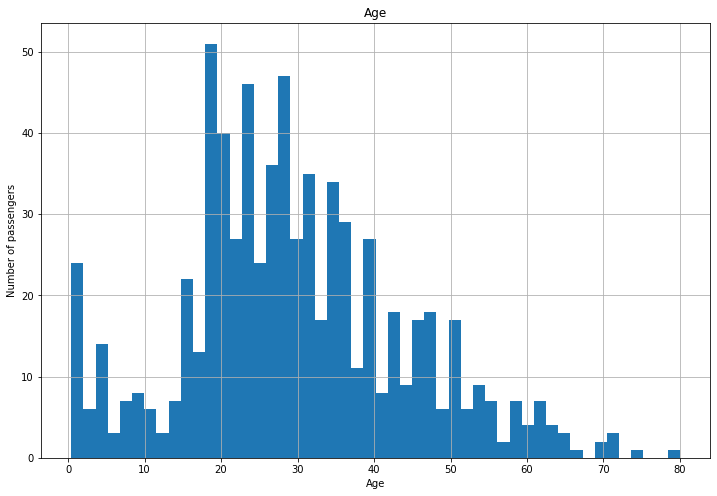
sns.boxplot('Age',data=df)
<matplotlib.axes._subplots.AxesSubplot at 0x7fd2c7a54910>
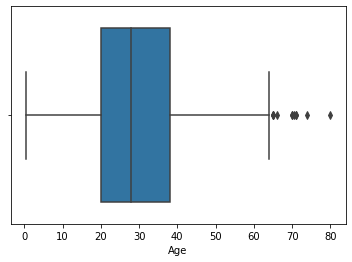
df.Age.describe()
count 714.000000
mean 29.699118
std 14.526497
min 0.420000
25% 20.125000
50% 28.000000
75% 38.000000
max 80.000000
Name: Age, dtype: float64
Assuming “Age” follows Gaussian distribution
# we will calculate boundaries which will differntiate outliers
# Boundary = [mean-3*std_dev,mean+3*std_dev]
age_mean=df.Age.mean()
age_std=df.Age.std()
upper_bound_age=age_mean+3*age_std
lower_bound_age=age_mean-3*age_std
print("upper Boundary:-",upper_bound_age)
print("mean:-",age_mean)
print("lower Boundary:-",lower_bound_age)
upper Boundary:- 73.27860964406095
mean:- 29.69911764705882
lower Boundary:- -13.88037434994331
- For Normally distributed dataset we will consider any value which is not between the above mentioned boundary as an outlier.
df.Age[~df.Age.between(lower_bound_age,upper_bound_age)].hist()
<matplotlib.axes._subplots.AxesSubplot at 0x7fd2af73fd10>
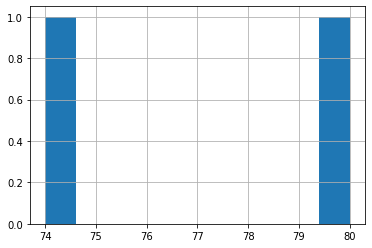
- Below steps we usually follow for Skewed dataset but just how it looks in case of Normally dataset we are trying these
## Lets compute the Inter Quantile Range (IQR) to calculate boundaries
IQR=df.Age.quantile(.75)-df.Age.quantile(.25)
IQR
17.875
lower_bridge=df.Age.quantile(0.25)-(1.5*IQR)
upper_bridge=df.Age.quantile(0.75)+(1.5*IQR)
print("upper Boundary:-",upper_bridge)
print("mean:-",age_mean)
print("lower Boundary:-",lower_bridge)
upper Boundary:- 64.8125
mean:- 29.69911764705882
lower Boundary:- -6.6875
df.Age[~df.Age.between(lower_bridge,upper_bridge)].hist()
<matplotlib.axes._subplots.AxesSubplot at 0x7fd2aff6b910>
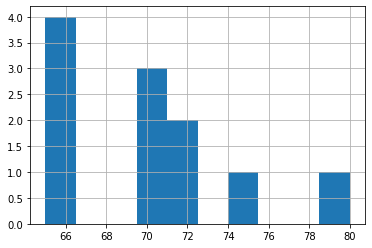
# Extreme Outliers
extreme_lower_bridge=df.Age.quantile(0.25)-(3*IQR)
extreme_upper_bridge=df.Age.quantile(0.75)+(3*IQR)
print("upper Boundary:-",extreme_upper_bridge)
print("mean:-",age_mean)
print("lower Boundary:-",extreme_lower_bridge)
upper Boundary:- 91.625
mean:- 29.69911764705882
lower Boundary:- -33.5
- It depends upon domain to decide the boundary for identifying outliers
Case 2 :- If features are skewed
plt.figure(figsize=(12,8))
figure=df.Fare.hist(bins=50)
figure.set_title('Fare')
figure.set_xlabel('Fare')
figure.set_ylabel('Number of passengers')
Text(0, 0.5, 'Number of passengers')
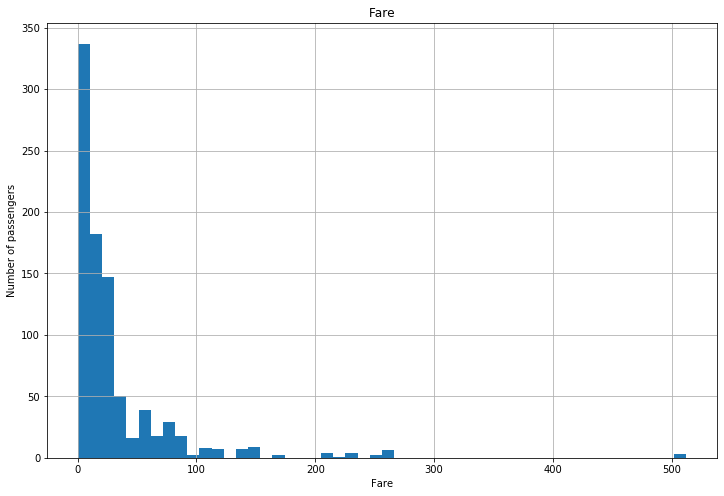
sns.boxplot('Fare',data=df)
<matplotlib.axes._subplots.AxesSubplot at 0x7fd2af840d50>
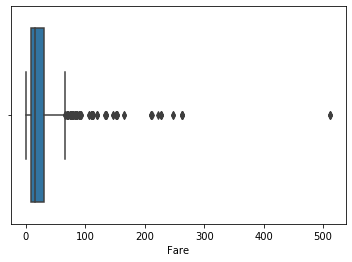
df.Fare.describe()
count 891.000000
mean 32.204208
std 49.693429
min 0.000000
25% 7.910400
50% 14.454200
75% 31.000000
max 512.329200
Name: Fare, dtype: float64
## Lets compute the Inter Quantile Range (IQR) to calculate boundaries
IQR=df.Fare.quantile(.75)-df.Fare.quantile(.25)
IQR
23.0896
fare_mean=df.Fare.mean()
lower_bridge=df.Fare.quantile(0.25)-(1.5*IQR)
upper_bridge=df.Fare.quantile(0.75)+(1.5*IQR)
print("upper Boundary:-",upper_bridge)
print("mean:-",fare_mean)
print("lower Boundary:-",lower_bridge)
upper Boundary:- 65.6344
mean:- 32.2042079685746
lower Boundary:- -26.724
# Extreme Outliers
extreme_lower_bridge=df.Fare.quantile(0.25)-(3*IQR)
extreme_upper_bridge=df.Fare.quantile(0.75)+(3*IQR)
print("upper Boundary:-",extreme_upper_bridge)
print("mean:-",fare_mean)
print("lower Boundary:-",extreme_lower_bridge)
upper Boundary:- 100.2688
mean:- 32.2042079685746
lower Boundary:- -61.358399999999996
- As we can see my data is very much skewed we should take extreme outliers boundary for outliers identification
- It also depends upon domain to decide the boundary for identifying outliers
Aplying Outliers Treatment in Machine Learning models
data=df.copy()
data.loc[data.Age>upper_bound_age,'Age']=int(upper_bound_age)
data.loc[data.Fare>extreme_upper_bridge,'Fare']=extreme_upper_bridge
- We are not replacing outliers below boundaries as we can see are no points below lower boundaries as age and fare can not be negative
- In scenario where there would have been outliers below lower boundary, we would have replaced the same with lower boundary
data.Age.hist(bins=50)
<matplotlib.axes._subplots.AxesSubplot at 0x7fd2b140d650>
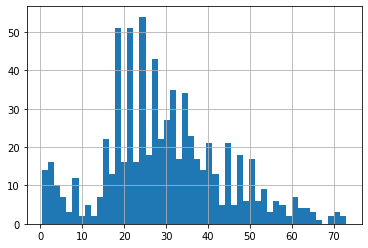
data.Fare.hist(bins=50)
<matplotlib.axes._subplots.AxesSubplot at 0x7fd2b16a1390>
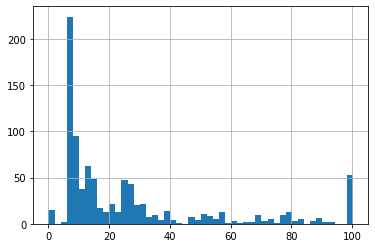
from sklearn.model_selection import train_test_split
X_train,X_test,y_train,y_test=train_test_split(data[['Age','Fare']].fillna(0),data.Survived,test_size=0.3,random_state=0)
X_train.shape
(623, 2)
from sklearn.linear_model import LogisticRegression
logit=LogisticRegression()
logit.fit(X_train,y_train)
LogisticRegression()
y_pred=logit.predict(X_test)
y_pred_1=logit.predict_proba(X_test)
from sklearn.metrics import classification_report,confusion_matrix,roc_auc_score,accuracy_score
print("confusion_matrix:-\n",confusion_matrix(y_test,y_pred))
print("\n classification_report:- \n",classification_report(y_test,y_pred))
print("\n accuracy_score:- \n",accuracy_score(y_test,y_pred))
print("\n roc_auc_score:- \n",roc_auc_score(y_test,y_pred_1[:,1]))
confusion_matrix:-
[[157 11]
[ 68 32]]
classification_report:-
precision recall f1-score support
0 0.70 0.93 0.80 168
1 0.74 0.32 0.45 100
accuracy 0.71 268
macro avg 0.72 0.63 0.62 268
weighted avg 0.72 0.71 0.67 268
accuracy_score:-
0.7052238805970149
roc_auc_score:-
0.7149404761904762
# Random Forest
from sklearn.ensemble import RandomForestClassifier
classifier=RandomForestClassifier()
classifier.fit(X_train,y_train)
y_pred=classifier.predict(X_test)
y_pred_1=classifier.predict_proba(X_test)
print("confusion_matrix:-\n",confusion_matrix(y_test,y_pred))
print("\n classification_report:- \n",classification_report(y_test,y_pred))
print("\n accuracy_score:- \n",accuracy_score(y_test,y_pred))
print("\n roc_auc_score:- \n",roc_auc_score(y_test,y_pred_1[:,1]))
confusion_matrix:-
[[134 34]
[ 40 60]]
classification_report:-
precision recall f1-score support
0 0.77 0.80 0.78 168
1 0.64 0.60 0.62 100
accuracy 0.72 268
macro avg 0.70 0.70 0.70 268
weighted avg 0.72 0.72 0.72 268
accuracy_score:-
0.7238805970149254
roc_auc_score:-
0.7389880952380952
## Running ML techniques without handling outliers
# Logistic
from sklearn.model_selection import train_test_split
X_train,X_test,y_train,y_test=train_test_split(df[['Age','Fare']].fillna(0),df.Survived,test_size=0.3,random_state=0)
logit=LogisticRegression()
logit.fit(X_train,y_train)
y_pred=logit.predict(X_test)
y_pred_1=logit.predict_proba(X_test)
from sklearn.metrics import classification_report,confusion_matrix,roc_auc_score,accuracy_score
print("confusion_matrix:-\n",confusion_matrix(y_test,y_pred))
print("\n classification_report:- \n",classification_report(y_test,y_pred))
print("\n accuracy_score:- \n",accuracy_score(y_test,y_pred))
print("\n roc_auc_score:- \n",roc_auc_score(y_test,y_pred_1[:,1]))
confusion_matrix:-
[[161 7]
[ 75 25]]
classification_report:-
precision recall f1-score support
0 0.68 0.96 0.80 168
1 0.78 0.25 0.38 100
accuracy 0.69 268
macro avg 0.73 0.60 0.59 268
weighted avg 0.72 0.69 0.64 268
accuracy_score:-
0.6940298507462687
roc_auc_score:-
0.71375
- As we can see Logistic performs better if we treat outliers
# Random Forest
from sklearn.ensemble import RandomForestClassifier
classifier=RandomForestClassifier()
classifier.fit(X_train,y_train)
y_pred=classifier.predict(X_test)
y_pred_1=classifier.predict_proba(X_test)
print("confusion_matrix:-\n",confusion_matrix(y_test,y_pred))
print("\n classification_report:- \n",classification_report(y_test,y_pred))
print("\n accuracy_score:- \n",accuracy_score(y_test,y_pred))
print("\n roc_auc_score:- \n",roc_auc_score(y_test,y_pred_1[:,1]))
confusion_matrix:-
[[134 34]
[ 42 58]]
classification_report:-
precision recall f1-score support
0 0.76 0.80 0.78 168
1 0.63 0.58 0.60 100
accuracy 0.72 268
macro avg 0.70 0.69 0.69 268
weighted avg 0.71 0.72 0.71 268
accuracy_score:-
0.7164179104477612
roc_auc_score:-
0.7361011904761905
- As we can see, Random Forest is not much changed even after treating outliers.

